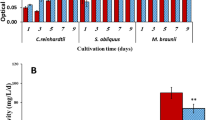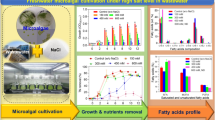Abstract
Despite the significant breakthroughs in research on microalgae as a feedstock for biodiesel, its production cost is still much higher than that of fossil diesel. One possible solution to overcome this problem is to optimize algal growth and lipid production in wastewater. The present study examines the optimization of pretreatment of municipal wastewater and aeration conditions in order to enhance the lipid productivity of Scenedesmus obliquus. Results showed that no significant differences were recorded in lipid productivity of S. obliquus grown in primary settled or sterilized municipal wastewater; however, ultrasound pretreatment of wastewater significantly decreased the lipid production. Whereas, aeration rates of 0.2 vvm significantly increased lipid content by 51 %, with respect to the non-aerated culture, which resulted in maximum lipid productivity (32.5 mg L−1 day−1). Furthermore, aeration enrichment by 2 % CO2 resulted in increase of lipid productivity by 46 % over the CO2 non-enriched aerated culture. Fatty acid profile showed that optimized aeration significantly enhanced monounsaturated fatty acid production, composed mainly of C18:1, by 1.8 times over the non-aerated S. obliquus culture with insignificant changes in polyunsaturated fatty acid proportion; suggesting better biodiesel characteristics for the optimized culture.



Similar content being viewed by others
References
Singh A, Olsen SI (2011) A critical review of biochemical conversion, sustainability and life cycle assessment of algal biofuels. Appl Energy 88(10):3548–3555
Abomohra A, El-Sheekh M, Hanelt D (2014) Pilot cultivation of the chlorophyte microalga Scenedesmus obliquus as a promising feedstock for biofuel. Biomass Bioenergy 64:237–244
Jiang L, Luo S, Fan X, Yang Z, Guo R (2011) Biomass and lipid production of marine microalgae using municipal wastewater and high concentration of CO2. Appl Energy 88(10):3336–3341
Yang J, Xu M, Zhang X, Hu Q, Sommerfeld M, Chen Y (2011) Life-cycle analysis on biodiesel production from microalgae: water footprint and nutrients balance. Bioresour Technol 102(1):159–165
Ketheesan B, Nirmalakhandan N (2011) Development of a new airlift-driven raceway reactor for algal cultivation. Appl Energy 88(10):3370–3376
Chen G, Zhao L, Qi Y (2015) Enhancing the productivity of microalgae cultivated in wastewater toward biofuel production: a critical review. Appl Energy 137:282–291
de la Noüe J, Laliberté G, Proulx D (1992) Algae and waste water. J Appl Phycol 4(3):247–254
Martijn EJ, Redwood M (2005) Wastewater irrigation in developing countries—limitations for farmers to adopt appropriate practices. Irrig Drain 54(S1):S63–S70
Diaz RJ, Rosenberg R (2008) Spreading dead zones and consequences for marine ecosystems. Science 321:926–929
Flotats X, Bonmatí A, Fernández B, Magrí A (2009) Manure treatment technologies: on-farm versus centralized strategies. NE Spain as case study. Bioresour Technol 100(22):5519–5526
Dawah A, Soliman A, Abomohra A, Battah M, Anees D (2015) Influence of alum on cyanobacterial blooms and water quality of earthen fish ponds. Environ Sci Pollut Res. doi:10.1007/s11356-015-4826-7
Zhou W, Min M, Li Y, Hu B, Ma X, Cheng Y, Liu Y, Chen P, Ruan R (2012) A hetero-photoautotrophic two-stage cultivation process to improve wastewater nutrient removal and enhance algal lipid accumulation. Bioresour Technol 110:448–455
Tu R, Jin W, Xi T, Yang Q, Han S, Abomohra A (2015) Effect of static magnetic field on the oxygen production of Scenedesmus obliquus cultivated in municipal wastewater. Water Res. doi:10.1016/j.watres.2015.07.039
Abomohra A, Wagner M, El-Sheekh M, Hanelt D (2013) Lipid and total fatty acid productivity in photoautotrophic fresh water microalgae: screening studies towards biodiesel production. J Appl Phycol 25(4):931–936
Kessler E, Czygan FC (1970) Physiologische und biochemische Beiträge zur Taxonomie der Gattung Chlorella. Arch Mikrobiol 70:211–216
Folch J, Lees M, Sloane Stanley GH (1957) A simple method for the isolation and purification of total lipids from animal tissues. J Biol Chem 226(1):497–509
Kaczmarzyk D, Fulda M (2010) Fatty acid activation in Cyanobacteria mediated by acyl-acyl carrier protein synthetase enables fatty acid recycling. Plant Physiol 152(3):1598–1610
Elliott LG, Feehan C, Laurens LML, Pienkos PT, Darzins A, Posewitz MC (2012) Establishment of a bioenergy-focused microalgal culture collection. Algal Res 1:102–113
El-Sheekh M, Abomohra A, Hanelt D (2013) Optimization of biomass and fatty acid productivity of Scenedesmus obliquus as a promising microalga for biodiesel production. World J Microbiol Biotechnol 29:915–922
Orpez R, Martinez ME, Hodaifa G, Yousfi FE, Jbari N, Sanchez S (2009) Growth of the microalga Botryococcus braunii in secondarily treated sewage. Desalination 246:625–630
Aravantinou A, Theodorakopoulos M, Manariotis I (2013) Selection of microalgae for wastewater treatment and potential lipids production. Bioresour Technol 147:130–134
Gupta S, Ansari F, Shriwastav A, Sahoo N, Rawat I, Bux F (2016) Dual role of Chlorella sorokiniana and Scenedesmus obliquus for comprehensive wastewater treatment and biomass production for bio-fuels. J Cleaner Prod 115:255–264
Ji M, Yun H, Park Y, Kabra A, Oh I, Choi J (2015) Mixotrophic cultivation of a microalga Scenedesmus obliquus in municipal wastewater supplemented with food wastewater and flue gas CO2 for biomass production. J Environ Manag 159:115–120
Zhang C, Zhang Y, Zhuang B, Zhou X (2014) Strategic enhancement of algal biomass, nutrient uptake and lipid through statistical optimization of nutrient supplementation in coupling Scenedesmus obliquus-like microalgae cultivation and municipal wastewater treatment. Bioresour Technol 171:71–79
Shen Q, Jiang J, Chen L, Cheng L, Xu X, Chen H (2015) Effect of carbon source on biomass growth and nutrients removal of Scenedesmus obliquus for wastewater advanced treatment and lipid production. Bioresour Technol 190:257–263
Voltolina D, Corderoieves B, Nieves M, Soto LP (1999) Growth of Scenedesmus sp. in artificial wastewater. Bioresour Technol 68:265–268
Pilli S, Bhunia P, Yan S, LeBlanc R, Tyagi R, Surampalli R (2011) Ultrasonic pretreatment of sludge: a review. Ultrason Sonochem 18:1–18
Ryu B, Kim EJ, Kim H, Kim J, Choi Y, Yang J (2014) Simultaneous treatment of municipal wastewater and biodiesel production by cultivation of Chlorella vulgaris with indigenous wastewater bacteria. Biotechnol Bioprocess Eng 19(2):201–210
Li Y, Chen YF, Chen P, Min M, Zhou W, Martinez B, Zhu J, Ruan R (2011) Characterization of a microalga Chlorella sp. well adapted to highly concentrated municipal wastewater for nutrient removal and biodiesel production. Bioresour Technol 102(8):5138–5144
Diaz MJ, Madejón E, López F, López R, Cabrera F (2002) Optimization of the rate vinasse/grape marc for co-composting process. Process Biochem 37(10):1143–1150
Barbosa MJ, Albrecht M, Wijffels RH (2003) Hydrodynamic stress and lethal events in sparged microalgae cultures. Biotechnol Bioeng 83:112–120
Sitanggang AB, Wu H, Wang SS, Ho Y (2010) Effect of pellet size and stimulating factor on the glucosamine production using Aspergillus sp. BCRC 31742. Bioresour Technol 101(10):3595–3601
Chen F, Johns MR (1991) Effect of C/N ratio and aeration on the fatty acid composition of heterotrophic Chlorella sorokiniana. J Appl Phycol 3(3):203–209
Saad N, Abdeshahian P, Kalil MS, Yusoff WW, Abdul Hamid A (2014) Optimization of aeration and agitation rate for lipid and gamma linolenic acid production by Cunninghamella bainieri 2A1 in submerged fermentation using response surface methodology. Sci World J 2014:280146
Fan KW, Jiang Y, Faan YW, Chen F (2007) Lipid characterization of Mangrove thraustochytrid Schizochytrium mangrovei. J Agric Food Chem 55:2906–2910
Robinson SP, Portis AR (1989) Ribulose-1,5-bisphosphate carboxylase/oxygenase activase protein prevents the in vitro decline in activity of ribulose-1,5-bisphosphate carboxylase/oxygenase. Plant Physiol 90(3):968–971
Yoo C, Jun SY, Lee JY, Ahn CY, Oh HM (2010) Selection of microalgae for lipid production under high levels carbon dioxide. Bioresour Technol 101(1):71–74
Damiani MC, Popovich CA, Constenla D, Leonardi PI (2010) Lipid analysis in Haematococcus pluvialis to assess its potential use as a biodiesel feedstock. Bioresour Technol 101(11):3801–3807
EN 14214:2008+A1 (2009) Automotive fuels. Fatty acid methyl esters (FAME) for diesel engines. Requirements and test methods. British Standards, ISBN 978 0 580 70781 0
Song M, Pei H, Hu W, Ma G (2013) Evaluation of the potential of 10 microalgal strains for biodiesel production. Bioresour Technol 141:245–251
Ma Y, Wang Z, Yu C, Yin Y, Zhou G (2014) Evaluation of the potential of 9 Nannochloropsis strains for biodiesel production. Bioresour Technol 167:503–509
Stournas S, Lois E, Serdari A (1995) Effects of fatty acid derivatives on the ignition quality and cold flow of diesel fuel. J Am Oil Chem Soc 72:433–437
Knothe G (2006) Analyzing biodiesel: standards and other methods. J Am Oil Chem Soc 83:823–833
Knothe G (2008) “Designer” biodiesel: optimizing fatty ester composition to improve fuel properties. Energy Fuels 22:1358–1364
Hoekman SK, Broch A, Robbins C, Ceniceros E, Natarajan M (2012) Review of biodiesel composition, properties, and specifications. Renew Sustain Energy Rev 16:143–169
Acknowledgments
We are grateful to the anonymous reviewers for suggesting insightful comments which led to a much improved manuscript. Financial support from Open Project of State Key Laboratory of Urban Water Resource and Environment, Harbin Institute of Technology (Project number HCK201508) is highly appreciated.
Author information
Authors and Affiliations
Corresponding author
Ethics declarations
Conflict of interest
The authors declare that they have no competing interests.
Rights and permissions
About this article
Cite this article
Han, SF., Jin, W., Tu, R. et al. Optimization of aeration for biodiesel production by Scenedesmus obliquus grown in municipal wastewater. Bioprocess Biosyst Eng 39, 1073–1079 (2016). https://doi.org/10.1007/s00449-016-1585-x
Received:
Accepted:
Published:
Issue Date:
DOI: https://doi.org/10.1007/s00449-016-1585-x




